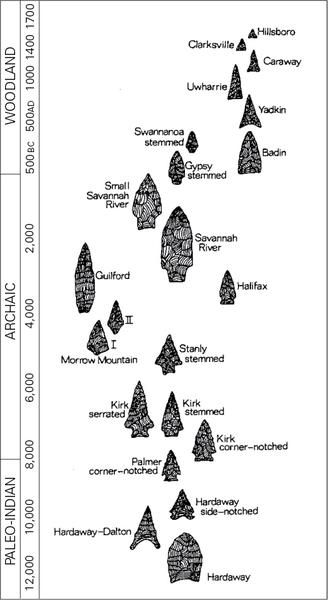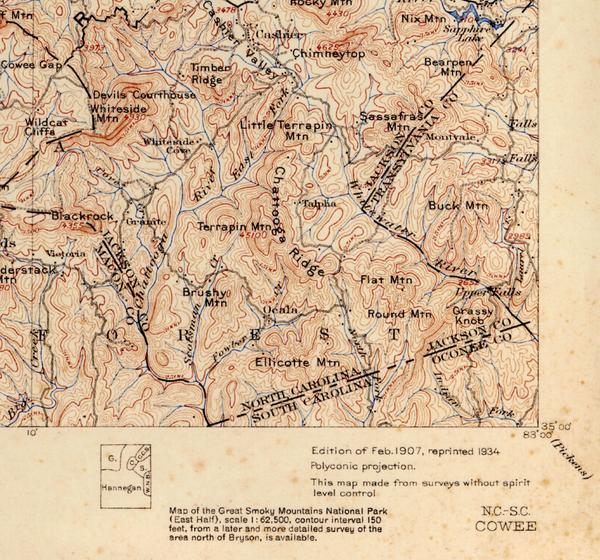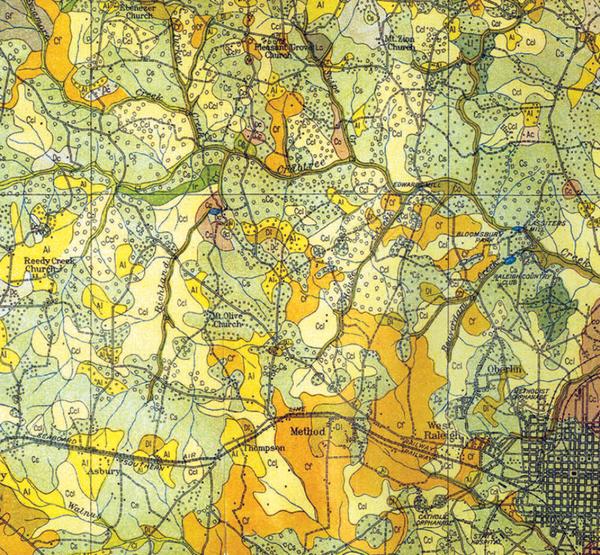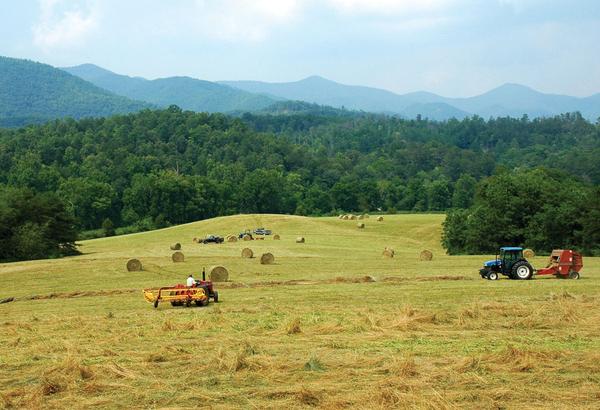As a landowner, you probably know of your responsibility to protect and preserve soil productivity, water quality, biological diversity, and wildlife habitat. But you may not be aware of other valuable resources potentially on your property: archeological artifacts, historic structures and landscapes, and culturally important vegetation.
These are known collectively as cultural resources, and this publication will help you learn more about identifying, protecting, and conserving these resources on your land through the creation of a preservation plan.
What Are Cultural Resources?
Cultural resources refers to landscapes, structures, archeological artifacts, and vegetation that represent a culture or society. These remains are pieces of history that can provide a glimpse into the technology, culture, and environment of earlier societies and reveal much about our country’s origins and development. Cultural resources can inform us about our evolving relationship with the natural world.
Manmade cultural resources include earthen mounds, buildings (and building remains such as chimneys, stone walls and terraces, mines, transportation routes (roads, trails, paths, fords, bridge sites), and artifacts. Natural cultural resources can include landscapes, landforms (e.g., caves), plants, and plant assemblages.
Prehistoric artifacts include chipped stone tools, ground and polished tools, animal bone tools and ornaments, and pottery. Historic artifacts include glass bottles, ceramic containers, and metal tools. Artifacts also may include broken or flaked workable stone, nails, buttons, and coins, which are invaluable in dating European sites.
A cultural landscape is “a geographic area, including both cultural and natural resources and the wildlife or domestic animals therein, associated with a historic event, activity, or person or exhibiting other cultural or aesthetic values” (Birnbaum, 1994). Nearly all cultural landscapes evolve from, or are dependent on, natural resources.
Importance of Cultural Resources
Cultural resources can help landowners and communities appreciate and understand the long-term effects of human activities and the resilience of nature. The identification and study of such resources and other evidence increase our knowledge of land management and of the daily activities of our ancestors and previous cultures. Some artifacts, sites, or natural resources have sacred value to Native American cultures and are irreplaceable links to our past society.
Our current understanding of Native American habitation is based on decades of archaeological field work done since the 1900s. Archaeological sites in North Carolina have revealed more than 12,000 years of human habitation prior to the arrival of Europeans. Archeology is also the principal method by which we understand the early historic period of European and African contact and settlement (NC 2006-2012 Historic Preservation Plan).
Benefits of Protecting Cultural Resources
Wise stewardship of cultural resources and landscapes protects the character and historical significance of a place. Landscapes provide scenic, economic, ecological, social, recreational, and educational opportunities that help us understand our cultural heritage. Ongoing preservation of cultural resources provides a richer sense of place and quality of life for all and a legacy for future generations.
Locating Cultural Resources
Artifacts can be found anywhere, but most artifacts and other evidence of historic cultural activities are located near former campsites or settlements and are often found near surface water, particular land forms and soil types, or mineral deposits. Historically, settlement near lakes, streams, and springs was essential for drinking water, food, sanitation, transportation, and defense.
Remnants of ancient transportation routes such as trails, trading paths, and early pioneer wagon roads can still be found today through-out the Southeast and can provide clues for locating old settlements and other archaeology. The early routes were logical and inevitable—the result of thousands of years of Native Americans’ interactions with animals, tribal migration, relocations, population shifts, and lifestyle changes due to European contact and trade. The historical corridors and remnants of these trails and roads should be identified, mapped, and their history preserved as a valuable element of Native American and early Euro-American heritage. Landowners with the features on their property may want to contact the State Historic Preservation Office.
Landforms such as caves, rock overhangs, protected coves, knolls, high bluffs, and stream terraces provided shelter, vantage points for hunting and defense, and level land for farming, respectively. Farming occurred where soil fertility was high and where loose soils could be tilled with simple tools (hoes and digging sticks), typically on broad floodplains of large streams and rivers. Clay deposits were used for ceramics, and outcrops of certain types of stone were used as materials for stone tools, smoking pipes, and ornaments. If these features are present on your property, look for artifacts such as projectile points (Figure 1) or pottery shards.
Certain tree and other plant species may also have been critical to the lifestyle of earlier societies, and some may have been semi-domesticated, being transplanted or otherwise encouraged near farming settlements. The North Carolina Natural Heritage Program or your local Extension agent can help determine the importance of rare plants you notice on your property.
Stewardship of Cultural Resources
Cultural resources located or collected on your property are a great source of pride and connection to the past. Artifacts found on private land belong to you, the landowner. However, there are protective steps to ensure that significant cultural resources are conserved for future generations and society in general. These steps include research, inventory, planning and reaching out to state technical services like the State Historic Preservation Office and/or federal technical services like the National Park Service Technical Preservation Services.
Technical resources can help prevent irrevocable damage to a cultural landscape. It is critically important to preserve the context of a site, as well as its content. The first step involves historical research, followed by an inventory and documentation of existing site conditions. These steps can help determine if a proposed management strategy of the on-site natural resources might affect an important historic or cultural resource. The field inventory and historical research can reveal cultural resources that should be protected. Once you have this information in hand, you can develop a cultural and historic preservation plan, or incorporate it into a land stewardship plan for your property.
Research
Research gives you a foundation to make educated decisions for management, maintenance, and regulatory compliance. As a landowner, you can conduct historical research on your property. The research findings can help identify your landscape’s historic period(s) of ownership, occupancy, and development, and bring you greater understanding of the qualities that make your landscape and its history significant. Various sources may be consulted for research and are available through your public library, town hall, the NC Office of State Archeology, or State Historic Preservation Office. Archival sources include:
- Historic plans
- Surveys and plats
- Property deeds
- Tax maps
- Atlases
- Geological survey maps
- Soil profiles
- Aerial photographs
- Photographs
- Paintings
- Newspapers and journals
- Construction drawings
- Personal correspondence
- Published histories
- Local preservation plans
- Scholarly articles
Surveys, aerial, and infrared photographs, interviews, Natural Resources Conservation Service maps, inventories, and investigations, can often be useful resources. Oral histories of long-term residents, managers, and maintenances personnel can be valuable as well. Your local nonprofit historical society, if one exists, may also be of help.
Within cultural landscapes, plants may have historical or botanical significance. A plant may have been associated with a historic figure or event or be part of a notable landscape design. An uncommon cultivator, a plant, may be an exceptional in size or age, rare, or commercially unavailable. Such plants contribute to the historical integrity and biological diversity of the cultural landscape.
Case Study: Cultural Landscape Preservation in Western North Carolina
Cowee-West’s Mill Historic District
Mainspring Conservation Trust (Mainspring), a nonprofit land conservation organization located in Franklin, NC, has been working since its inception in 1997 with private landowners to protect the natural and cultural heritage of the upper Little Tennessee River corridor in Macon County. One of the first projects was to research, inventory, and apply for National Register status for the Cowee-West’s Mill Historic District. For thousands of years, the valley surrounding the confluence of Cowee Creek and the river has been a center of human settlement because of its fertile soils and accessibility to water sources.
Cowee Mound
The west end of the district contains Cowee Mound. The prehistoric Cowee Mound, one of the few remaining earthen mounds in western NC and one of the most significant archaeological sites in the region, was most likely built by Native Americans during the Middle Mississippian period (1200–1400 C.E.)
The indigenous people of this southern Appalachian region are known today as the Cherokee. By the mid-1800s, merchants knew the town of Cowee as the largest center of trade with the Cherokee people. At the time of William Bartram’s visit in 1775, Cowee town consisted of about 100 dwellings situated on both sides of the river and was dominated by a large circular townhouse sitting atop the ancient mound. Cowee was continuously occupied by the Cherokee until 1819, when a federal treaty relinquished Cherokee lands east of the Nantahala Mountains.
In 2007, Mainspring was able to acquire the 53-acre property containing Cowee Mound. After placing it under a conservation easement with the State of North Carolina through the NC Clean Water Management Trust Fund protecting it from future development, the property was sold to the Eastern Band of Cherokee Indians (EBCI).
Since then, Mainspring has worked with the EBCI to help manage the property. A multiple resource management plan has inventoried and documented the natural and cultural resources on the property, which has helped guide management actions. While the upland fields continue to be managed for hay, the botanically rich bottom land floodplain is being managed for water quality protection, early successional wildlife habitat, and cultural resources.
Management includes maintenance of forested riparian buffers, control of invasive exotic plant species, periodic prescribed fire, and vegetation management to favor expansion of river cane canebrakes.
River Cane
Principal among the property's cultural resources is river cane (Arundinaria gigantea), a native eastern North American bamboo species and a plant of particular importance to the Cherokee. This species can form large dense stands called “canebrakes,” which were a dominant feature of the pre-settlement landscape. Because they often grow on excel-lent agricultural soils, canebrakes were rapidly eliminated following European settlement. Today, canebrakes cover less than 2 percent of their former extent, with large canebrakes essentially non-existent.
Besides the unique environmental benefits offered by canebrakes (protection of water quality through soil stabilization, capture of urban and agricultural runoff, mitigation of flood damage, and support of important wildlife habitat), river cane has always been a culturally significant plant for the Cherokee people. Traditionally, it was used as raw material for numerous craft items such as baskets, spears, arrows, blowguns, fish traps, sleeping mats, flutes, and tobacco pipes, as well as shelter building materials.
Today, a limiting factor for Cherokee tourism development has been the scarcity of the river cane resource for producing high-value craft items. As the Cherokee train new basket makers to revitalize their culture and expand tourism, the need for cane is rapidly expanding.
At Cowee Mound and elsewhere along the Little Tennessee River corridor, Mainspring is working with its EBCI partners and other landowners to expand, provide access, and sustainably manage this cultural resource through control of invasive exotic plants and other competing vegetation, negotiation of access rights, and regulated harvests by Cherokee artisans.
An example is the river cane (Arundinaria gigantea) found in western North Carolina, which is highly valued by the Eastern Band of Cherokee Indians for its traditional use in basket making (see above). A thorough site inventory will reveal the presence of such important plants, as well as other natural features of the site.
Inventorying and Documenting Existing Conditions
The goal of the cultural resource inventory is to identify and document the cultural resources on your property as they exist at the present. As previously indicated, these may include both manmade and natural cultural resources, and include both prehistoric and historic artifacts. Intensive field investigation and reconnaissance may be required to assess current conditions of these resources. Herbaceous plants of the property may require inventories in different seasons.
The Cultural/Historic Preservation Plan
Both physical evidence in the landscape and historic documentation are needed to create a cultural and historic preservation plan. The plan will also include goals and activities or treatments for preserving and protecting these cultural and historic resources. In most cases, the existence of cultural resources will not change your land management activities or objectives. Most significant cultural resource sites can best be protected by avoiding key areas or modifying the intensity of soil-disturbing activities.
Documentation of your research and inventory efforts will serve both you and future landowners for generations to come.
Seeking Help
If in doubt about the significance of cultural resources on your property, seek assistance. The NC Office of Archives and History, particularly the Office of State Archaeology and State Historic Preservation Office, can offer guidance. Your local historical society may help you learn about the history of your property. Local preservation commissions, the National Park Service, local and state park agencies, or the private, nonprofit organization Preservation North Carolina, may also be of help. Cooperative Extension agents and specialists, as well as the NC Natural Heritage Program, can help you learn about culturally significant plants.
Although responsible forest and land stewards would never knowingly disturb cultural resources, laws do protect certain sites. Legal statutes protect cultural resources if they are found on state or federal land, if government assistance is provided (such as certain state or federal cost-share programs), or if federal permits are needed for a management activity. Human burial sites and cemeteries are always protected. If cultural resources are found on your land, public funds may be available to help you preserve them.
Sources of Information and Assistance
North Carolina Office of Archives and History (OAH) — is part of the NC Department of Cultural Resources. The mission is to collect, preserve, and utilize the state’s historic resources so that present and future residents may better understand their history. The agency provides leadership and assistance to encourage the stewardship of historic resources by government agencies, private individuals, and business and nonprofit organizations throughout the state. The OAH includes the NC State Historic Preservation Office (SHPO) and the Office of State Archaeology (OSA).
North Carolina’s State Historic Preservation Office (SHPO) — assists private citizens, private institutions, local governments, and agencies of state and federal government in the identification, evaluation, protection, and enhancement of properties significant in North Carolina history and archaeology. The SHPO implements state and federal preservation programs and has four branches: Administration, Environmental Review, Survey and Planning, and Restoration. The Environmental Review branch coordinates review of federal and state undertakings to assess their potential effect on historic properties and districts. The Survey and Planning branch administers the statewide architectural and historic building survey and the National Register of Historic Places for historic structures and advises local historic preservation commissions. The Restoration branch provides technical restoration assistance to public and private owners of historic properties and assists owners seeking federal and state historic preservation investment tax credits.
The SHPO provides access to surveys, field notes, photographs, research reports, National Register nominations, and maps to assist in evaluation and planning related to preserving historic and cultural resources. The SHPO can also perform site visits, advise about National Register eligibility, provide technical advice regarding historic building maintenance and preservation, and provide general advice and referrals to other preservation organizations such as Preservation North Carolina.
North Carolina Office of State Archaeology (OSA) — coordinates and implements a statewide program of prehistoric, historic, and underwater archaeology including (1) archaeological resource protection, (2) archaeological data inventory, (3) public education, (4) regulatory compliance review, and (5) technical assistance. The OSA protects endangered archaeological sites on private or public lands through enforcement of state statutes. The OSA also maintains a statewide, computer-based inventory of archaeological sites along with maps, photographs, artifact collections, and other data sources. Services OSA can provide to natural resource managers or landowners include performing map checks for recorded archaeological sites, performing site assessments for archaeological resources, performing site visits, reviewing the scope of work for archaeological surveys, and reviewing construction or project plans for potential effects on archaeological resources.
Preservation North Carolina — a private nonprofit state-wide historic preservation organization. Its mission is to protect and promote buildings, landscapes, and sites important to the diverse heritage of North Carolina. The organization provides answers to questions, resources, and services related to historic preservation.
Trading Path Association — a private nonprofit whose mission is to preserve, study, and promote the remnants of the historic Trading Path, which once connected the Chesapeake country with towns in the Carolinas and Georgia.
Southeastern Indian Trails Project — part of the private, nonprofit Wild South’s Cultural Heritage program. This program’s goal is to identify and protect culturally significant resources and landscapes across the Southeast. Contact Wild South’s cultural heritage assistant for more information.
Tribal Historic Preservation Office (THPO), Eastern Band of Cherokee Indians — responsible for protecting and preserving important Cherokee heritage sites throughout the tribe’s current and traditional lands. THPOs have the responsibilities of state historic preservation officers on tribal lands and advise and work with federal agencies on the management of tribal historic properties. THPOs also preserve and rejuvenate the unique cultural traditions and practices of their tribal communities.
Catawba Tribal Historic Preservation Office — Although the Catawba Indian Reservation is in South Carolina, the Catawba have ancestral lands in North Carolina and are consulted on a regular basis. Contact the Catawba Indian Tribe Tribal Historic Preservation Officer for more information.
North Carolina Commission of Indian Affairs — includes in its mission, “Promote recognition of and the right of Indians to pursue their cultural and religious traditions” and maintains information on all recognized tribes and organizations, along with contact information.
Revitalization of Traditional Cherokee Artisan Resources (RTCAR) — a multi-year grant-making program whose purpose is to assist the Eastern Band of Cherokee Indians (EBCI) as the tribe works to restore the traditional Cherokee balance between maintaining and using natural resources like river cane, white oak, and clay. Funded by Cherokee Preservation Foundation and operated through EBCI Cooperative Extension, RTCAR helps teach, protect, and promote Cherokee traditional art, resources, and land for present and future generations.
North Carolina Natural Heritage Program — part of the Office of Natural Resource Planning and Conservation within the NC Department of Environment and Natural Resources. By consolidating information about hundreds of rare species and natural communities, the program ensures that the public is able to get the information needed to weigh the ecological significance of various sites and to evaluate the likelihood and nature of ecological impacts. This information supports informed evaluations of the trade-offs associated with biological diversity and development projects before plans have been finalized and helps establish priorities for protecting North Carolina’s most significant natural areas.
North Carolina Land Trusts — non-profit organizations that protect natural areas of significant ecological, scenic, recreational, agricultural, cultural, or historic value. They work locally to protect farms, forests, animal and plant habitats, lakes and streams, parks, and scenic vistas that are treasured by the communities they serve. A land trust may acquire a property by buying it or as a donation from the owner. It may then hold the property or donate it to a government or another conservation group that will protect the land—as a watershed or a park, for example. Or the land trust may resell the tract as a conservation property, with an agreement that limits what the next owner can do with it. The land trust may acquire only the development rights to the land, by purchase or donation. That means the landowner can continue to live on or even farm the property under an agreement that limits changes that can be made to the land. These agreements, called easements, are completely voluntary, negotiated by the landowner and the land trust. The land trust or another agency will act as a steward of property under a conservation easement, monitoring it to make sure it is protected according to the agreement forever. To find the local land trust in your area, visit the Conservation Trust for North Carolina.
References
Birnbaum, Charles A. “Protecting Cultural Landscapes: Planning, Treatment and Management of Historic Landscapes.” United States National Park Service Preservation Briefs 36 (1994)
Florida Forest Steward. 2004. Newsletter, vol no 4 (Winter).
State of North Carolina - Historic Preservation Plan 2013-2022.
Other Recommended Reading
Advisory Council on Historic Preservation: Promoting Historic Preservation Across the Nation
National Park Service. 1999. Guidelines for Evaluating and Documenting Rural Historic Landscapes.
Ackowledgments
The authors thank Gary Blank, David Cozzo, and Mark Megalos for their review of an early version of this publication, as well as John Alger, Dolores Hall, and Tom Hatley for their valuable comments. Funding for this publication was provided by an RTCAR grant.
Publication date: Jan. 1, 2010
Reviewed/Revised: May 31, 2024
WON-45
N.C. Cooperative Extension prohibits discrimination and harassment regardless of age, color, disability, family and marital status, gender identity, national origin, political beliefs, race, religion, sex (including pregnancy), sexual orientation and veteran status.








